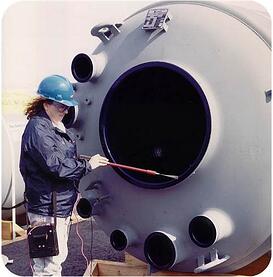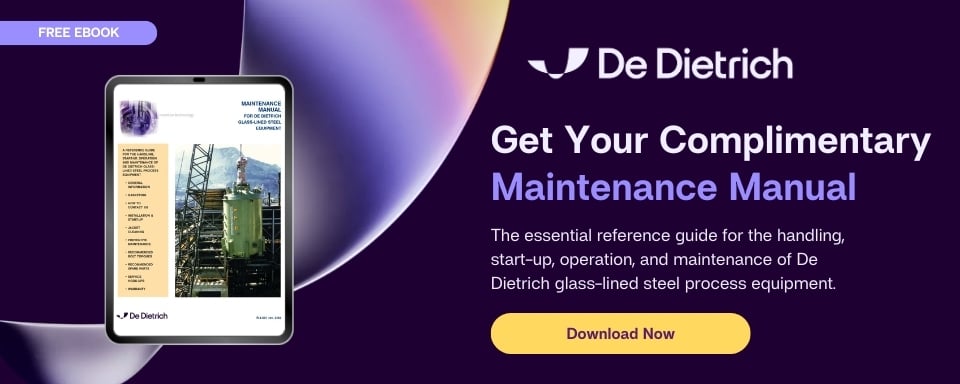12 Critical Do's and Don'ts for Glass-Lined Equipment (Part 2)
 In last week’s blog post, we talked about some best practices for operating and maintaining your glass-lined equipment, including what behaviors to avoid (get up to speed and read "part 1" if you haven't already). Concluding the list are six remaining “do’s” and “don’ts” that call for effective and efficient ways to safely handle glass-lined vessels.
In last week’s blog post, we talked about some best practices for operating and maintaining your glass-lined equipment, including what behaviors to avoid (get up to speed and read "part 1" if you haven't already). Concluding the list are six remaining “do’s” and “don’ts” that call for effective and efficient ways to safely handle glass-lined vessels.
7. Make sure you have your equipment spark tested by trained personnel who are thoroughly familiar with the procedure
DON’T use spark testers other than those recommended by the manufacturer
Spark testing is an important maintenance technique used on glass-lined equipment. It is used to locate defects in the glass lining of vessels and accessories, to perform routine preventive maintenance checks, to verify suspected failure, and to locate areas to be repaired. In-plant spark testing involves a 6000-volt source, either AC or DC. Higher voltages can damage the glass lining! The voltage potential is applied across the clean, dry glass surface by an insulated, hand-held fault probe. Any exposed metal causes a visible spark to jump between the probe and the flaw, alerting the operator to its location. Remember – spark testing can be a destructive test, especially when not done properly. We offer training seminars to teach your personnel the best way to inspect your equipment and identify potential areas of concern.
8. Make sure you flush spills immediately with water and neutralize all surfaces
DON’T allow spilled chemicals to remain on the vessel exterior
Exterior corrosion can eventually cause damage to the interior glass lining so it is a best practice to maintain cleanliness of the entire vessel, not just the inside. When cleaning the exterior of the vessel remember to be aware of the vessel temperature and the temperature of the liquid in order to not thermal shock the glass. Safe temperature differentials must be observed.
9. Make sure you monitor and approve all products prior to adding them into the vessel
DON’T charge materials through nozzles without filtering the contents
Filtering is extremely important because you want to make sure there are no foreign materials or large particles present that could cause damage to the glass. Any solid could impact the glass on the vessel or agitator blades and scratch the fire polish. Additionally, filtering your product will aid in the creation of a more homogeneous solution.
10. Make sure you adhere to the minimal level requirements to ensure safe mixing
DON’T operate the agitator with the liquid level at the blade level
When the agitator is run with the fluid in the vessel below the blade level, fluid flow causes the shaft to “skate”, resulting in excessive stresses and runout in the seal area and upper end of the agitator. This can cause premature seal failure and even glass damage on the agitator itself. The simple fix is to make sure there is the right volume of product in your vessel before turning on the agitator. If this becomes a regular problem, then it’s time to look into get a different sized reactor to meet your process needs.
11. Make sure you close and secure all openings to the vessel when they are not being used
DON’T leave the manway cover open
Anytime a manway cover is left open and unattended you run the risk of it accidentally slamming shut, an event that could cause serious fracturing of the glass and injury to your personnel. Furthermore, leaving a manway in the open position increases the risk of damage to the vessel from objects falling through the opening and impacting the internal lining. Always keep the manway in the closed position when you are not using it and consider a manway assist to avoid a cover slamming shut.
12. Make sure the vent is open when filling the vessel jacket
In the case of jacketed vessels, DON’T keep the jacket vent closed
The vent in the jacket is required to allow the air to escape the jacket when filling it with liquid. If the vent is not opened during filling you will run the risk of air pockets in the jacket, which will lead to poor performance and other potentially harmful problems.
Whether you have glass-lined equipment in production at your facility already or are considering it for your process, by following common sense precautions along with these outlined Do’s and Don’ts you can ensure that your equipment will operate in a safe manner for many years. We recommend consulting our free eBulletin “Installation and Maintenance Manual for De Dietrich Glass-Lined Steel Equipment” for even more information about caring for your glass-lined equipment.
